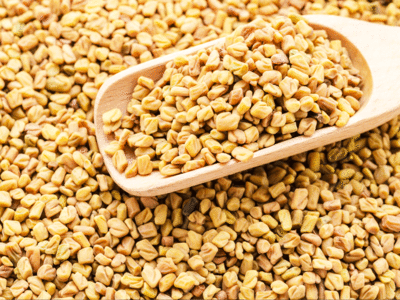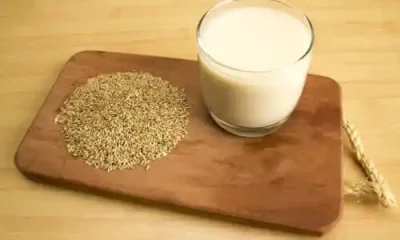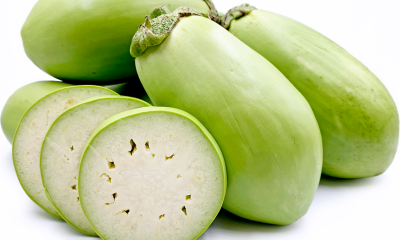Health
How to use fenugreek for diabetes and side effects

Discover how to use fenugreek for diabetes and side effects.
Among the treatments in traditional medicine against diabetes and cholesterol, we find fenugreek!
Many spices have a regulating effect on the level of sugar in the blood, among all these spices, we find fenugreek, also called trigonellin.
In this article, we will tell you about the effects of fenugreek on diabetes, how can it be used, and in which cases, as well as the side effects and contraindications for the use of the small yellowish seed.
To prepare the remedies in this article, you will need fenugreek powder or seeds of the species Trigonella foenum-graecum, the seeds of which have been used in Ayurvedic medicine since ancient times for their medicinal properties.
Diabetes: Origin, symptoms, and different types:
Diabetes is a chronic disease that affects many people in France. There is no cure for a cure, we just learn to live with, with the help of insulin, a hormone that is used to control the level of sugar in the blood.
When you have diabetes, insulin is no longer effective enough in this control, or the pancreas, the organ that creates insulin, no longer produces enough of this hormone, which causes an accumulation of sugar in the blood. blood.
However, several types of diabetes are differentiated, namely, prediabetes, type I diabetes, type II diabetes, and pregnancy diabetes.
There are mainly two types of diabetes:
• Type 1 diabetes: or insulin-dependent diabetes, about 6% of diabetics. It is characterized by insufficient production of insulin.
• Type 2 diabetes: or non-insulin-dependent diabetes, 92% of diabetics. It is characterized by initially an insulin resistance of certain organs which prevents the entry of insulin.
This resistance to the action of insulin leads to an overproduction of insulin by the pancreas to compensate, a pancreas that gets tired and after twenty years, no longer produces enough insulin: this is insulin deficiency.
You should know that this type of diabetes increases the risk of cardiovascular diseases by 2 to 4 times (heart attack, high blood pressure, etc.) and causes numerous disorders on the eyes, kidneys, etc.
What are the effects of fenugreek on diabetes?
Fenugreek is used in many traditional medicines, particularly in India, or Africa, for reasons as diverse as increasing the size of the breast or gaining weight naturally with fenugreek. It is also the oldest spice consumed for its aphrodisiac properties on women.
Among these uses, it is often used to aid in the control of glucose metabolism, in the prevention and treatment of diabetes, more specifically for pre-diabetics or people with type 2 diabetes, mild to moderate.
Its direct effect on diabetes:
Western medicine research tends to prove the effectiveness of spice. Among the many studies, 3 shows that fenugreek lowers and regulates blood sugar levels while reducing insulin resistance in patients with type 2 diabetes.
One of those studies involved taking 4 teaspoons of fenugreek powder every day for 8 weeks. Result: 25% drop in fasting blood sugar levels, as well as a 30% drop in triglycerides and LDL cholesterol, known as “bad cholesterol”.
Indeed, the small seed contributes to a better secretion and assimilation of insulin. The seeds contain an amino acid, 4-hydroxy isoleucine, known to stimulate insulin secretion by the pancreas.
This amino acid also helps reduce the body’s insulin resistance, characteristic of type 2 diabetes. The direct consequence is therefore a drop and regulation of blood sugar levels in the blood.
In addition, the spice contains essential compounds such as antioxidants and anti-inflammatories: quercetin, apigenin, genistein, rutin, kaempferol, or even selenium.
It is also rich in alkaloids such as gentian, campaign, or trigonelline. This exceptional composition makes fenugreek an effective spice in preventing cell degeneration, allowing, among other things, to protect the liver and pancreas.
The seed is rich in soluble fiber, which also affects the blood glucose level by delaying the digestion process, increasing the absorption of sugar in the intestines, and therefore reducing the level of sugar in the blood.
NB: By naturally regulating the insulin level, fenugreek will thus limit the production of androgen and sebum. This is what also makes it an acne remedy.
Other benefits for blood sugar:
Fenugreek has a regulating effect on the blood lipid level, making it possible to reduce LDL cholesterol, called bad cholesterol while increasing the good one.
At the same time, it helps reduce platelet aggregation in arteries and veins, which significantly reduces the risk of blood clotting associated with strokes and heart attacks.
Its dietary fiber reduces the absorption of fat and cholesterol in the intestines.
The seed is also rich in vitamins B1, B3, A, and C. It is also rich in vegetable proteins (30% of the weight of the seed), as well as calcium, phosphorus, iron, sulfur, and magnesium. It is also thanks to this exceptional composition that fenugreek is used for the health of the hair.
How to use fenugreek for diabetes
Be careful, always seek the advice of your doctor before embarking on any cure, particularly cures involving an effect on a disease such as diabetes.
Fenugreek is mainly consumed in three forms: seeds, powder, or capsules.
Use in seeds and powder:
The ideal amount seems to be 4 teaspoons of seeds per day, taken at different times of the day.
Prefer to use seeds that you will reduce to powder as and when you need it, using a spice mill, rather than fenugreek powder which will have undergone oxidation and will have lost its virtues.
Two ways to do it:
• Prepare an infusion by boiling a cup of water and infusing a tablespoon of fenugreek seeds (if possible ground) for 10 min. Drink this decoction 2 times a day.
• Integrate fenugreek powder into your diet by integrating it into all your recipes, it is a spice that will bring a very pleasant but rather discreet scent, so you can use it everywhere.
In the diet, it is excellent to germinate fenugreek seeds before consuming them, it is delicious and even better for your health!
Use in capsules:
The capsules are available in pharmacies, ask your pharmacist for advice and follow the instructions provided with the instructions for use.
Contraindications and side effects:
Always seek the advice of your doctor before undergoing a cure. If you have diabetes, you should take fenugreek under medical supervision.
There are few known side effects. Overconsumption can cause mild gastric disorders, due to the fibers in the spice. It is then sufficient to reduce the doses.
Also, you should know that fenugreek being detoxifying, tends to give a certain odor to sweat and urine which evacuates toxins, depending on the quantities consumed.
Pregnant women should not consume fenugreek, or else with caution and no more than dietary doses, as it is known to stimulate contact. It is also traditionally used to facilitate childbirth.
The dosages, natural home remedies, benefits, opinions, and contraindications of this article are given for information only. For any medical prescription and dosage, consult your doctor or pharmacist.
Health
14 Benefits of Oolong tea and side effects Table of Contents
Health
Contraindications of drinking green tea

Discover the contraindications of drinking green tea.
Drinking green tea in excess can cause some harmful side effects for the body, which are necessary to know
Green tea is one of the most popular in the world. In addition to having a characteristic flavor, its different properties make it a highly beneficial drink for health, mainly due to its antioxidant power. However, its consumption also includes a series of contraindications
Among the benefits of green tea highlights its ability to improve memory, helps lose body fat, increases physical performance, is stimulating, can prevent different types of cancer, and even reduce the risk of cardiovascular diseases.
Among all the types of green tea that exist, matcha stands out, a tea of oriental origin with important properties for health and that stands out for its powder composition. In recent years it has become the travel companion of celebrities, athletes, and famous people.
Contraindications of drinking green tea
Many people have incorporated green tea into their day-to-day. The truth is that it is a great choice since it can provide energy to face the workday, accelerate the metabolism, and can even help improve mood.
However, like any food, the consumption of green tea carries a series of contraindications that it is necessary to know.
Thus, from ‘Todo Disca’ we are going to expose some of the negative effects that the ingestion of this type of infusions can produce.
In this sense, researchers from the National Institute of Health of the United States affirm that the consumption of green tea mixed with different medications, such as contraceptive pills, antibiotics, stimulants, or alcohol can be harmful to health.
And these are some of the side effects that excess green tea consumption can generate for the body:
1. Irritability: Some people feel some discomfort at the time of their intake. That is to say, it produces an effect contrary to the one they seek at first.
2. Insomnia: Green tea can cause sleep problems for many people. And is that it is a stimulating drink that contains some doses of caffeine, although in a lower proportion than traditional coffee.
3. Dizziness and nausea: This infusion can be heavy for delicate stomachs and generate some type of gastrointestinal discomfort. Therefore, it is not advisable to take on an empty stomach.
4. Palpitations: Due to its stimulating characteristics, it can sometimes cause palpitations. Along these lines, experts recommend reading the indications and ingredients of all types of tea.
5. Disadvantages during pregnancy: Green tea is rich in tannins, so it can reduce the absorption of folic acid and iron. Due to this, this drink is not recommended for pregnant or lactating women.
Generally, green tea is an infusion with excellent health properties. In this way, moderate consumption usually brings different benefits to the body.
However, it is advisable to take these contraindications into account, and if you feel any side effects, see a medical specialist.
Through the following link, you will be able to know the contraindications to drink matcha tea, a variety of oriental origin widely established in Europe and whose consumption has become popular in recent years
Health
15 Benefits of pumpkin seeds and side effects

Table of Contents
- 1. Pumpkin seeds to boost the immune system
- 2. They are high in magnesium
- 3. Pumpkin seeds are low in calories
- 4. Pumpkin seeds are rich in iron
- 5. Relieve symptoms of irritable bladder
- 6. Pumpkin seeds are high in fiber
- 7. Benefits of pumpkin seeds for cholesterol
- 8. Pumpkin seeds are a natural anti-inflammatory
- 9. Pumpkin seed oil to counter the effects of menopause
- 10. Pumpkin seeds help healthy skin, hair and nails
- 11. Pumpkin seeds help eliminate kidney stones (kidney stone)
- 12. Pumpkin seeds are rich in vegetable protein
- 13. Pumpkin seeds are a great substitute for peanuts
- 14. benefits of pumpkin seeds on your hormonal health
- 15. Pumpkin seeds are a good source of potassium
- Discover the 15 powerful health benefits and virtues of pumpkin seeds and side effects.
They are packed with nutrients and vitamins, are high in protein, fiber and are low in calories!
-
1. Pumpkin seeds to boost the immune system
Pumpkin seed helps boost the immune system , especially because it is rich in zinc.
Remember that zinc allows the proper functioning of the immune system by ensuring optimal activity of T lymphocytes. Zinc could also help the body to better protect itself against colds, flu, conjunctivitis and other infections.
2. They are high in magnesium
Anxiety , migraines, muscle cramps and PMS can result from magnesium deficiency. A 28g serving of pumpkin seeds provides almost 20% of the recommended daily allowance.
The magnesium intervenes in the transformation of food into energy, the transmission of nerve impulses, muscle relaxation and the formation of bones and teeth.
- Acting with calcium and potassium, it regulates the heart rate and participates in the production of insulin.
Several studies have also demonstrated the virtues of magnesium in the prevention of cardiovascular disease.
3. Pumpkin seeds are low in calories
Pumpkin seeds are lower in calories than many nuts. A 28g serving of pumpkin seeds (2 tablespoons) without their raw shell has 126 calories, which is almost 40 calories less than almonds and 60 calories less than walnuts for a single serving.
4. Pumpkin seeds are rich in iron
Pumpkin seeds are a great source of iron. A 28g serving of pumpkin seeds provides almost 5% of the recommended daily allowance.
Remember that iron is essential for health and is involved in a multitude of functions in the human body, in addition to transporting oxygen through the body.
However, iron from plant sources is not as well absorbed as iron from animal sources. In this sense, it is recommended that vegetarians consume twice as much iron in order to ensure that they do not suffer from deficiencies that may in particular cause fatigue and weakness.
5. Relieve symptoms of irritable bladder
While more scientific studies are to be conducted on the subject to understand all of its mechanisms, pumpkin seeds are believed to help relieve symptoms of irritable bladder and urination disorders associated with benign prostatic hyperplasia (BPH). .
6. Pumpkin seeds are high in fiber
Pumpkin seeds also provide a healthy dose of fiber . A 28g serving of pumpkin seeds provides 5g of fiber, or 20% of the recommended daily intake.
In addition to calming hunger, fiber promotes healthy digestion and helps regulate bowel function.
7. Benefits of pumpkin seeds for cholesterol
The phytosterols in pumpkin seeds help lower ” bad” cholesterol levels . Phytosterol is the plant equivalent of cholesterol. However, rather than blocking the arteries, phytosterol rather helps to clean them, recalls WebMD.
8. Pumpkin seeds are a natural anti-inflammatory
Source of antioxidants, pumpkin seeds have an anti-inflammatory effect and thus help defend the body against damage caused by excess free radicals .
If free radicals oxidize DNA (the body’s genetic code) in a cell’s nucleus, a cell mutation can occur, which can start cancer. Oxidation of cholesterol in the blood can lead to the formation of fatty deposits in the arteries, which can lead to heart disease or stroke.
Excess free radicals are also involved in cataracts, immune deficiencies, arthritis and premature cell aging; their role in these diseases is the subject of intensive research.
9. Pumpkin seed oil to counter the effects of menopause
Researchers have studied the impact of pumpkin seed oil in better combating symptoms of menopause , including hot flashes and headaches.
While further studies need to be done, pumpkin seed oil has been shown to be effective in alleviating these symptoms in the subjects of this research.
10. Pumpkin seeds help healthy skin, hair and nails
The pumpkin seeds contain essential fatty acids, zinc, vitamin A and vitamin E . These nutrients help maintain glowing skin , strong, healthy hair and nails .
While more research is needed to confirm these benefits, a study with 76 participants also looked at the benefits of pumpkin seed oil in helping hair regrowth in men with alopecia.
In subjects who consumed 400mg of pumpkin seed oil for 24 weeks, regrowth was 40% greater than participants who took a placebo.
11. Pumpkin seeds help eliminate kidney stones (kidney stone)
Pumpkin seeds are also said to prevent kidney stones from forming . To better counter kidney stones, it is also recommended to drink plenty of water, limit sodium intake, and consume no more than 2g of vitamin C on a daily basis.
The kidneys are designed to remove particles of salts and minerals that end up in the ureter, a long, narrow duct leading to the bladder; they will then be expelled in the urine.
Problems arise when a chemical imbalance or other deficient process promotes the agglutination of particles, which turn into crystals and then into a kidney stone.
12. Pumpkin seeds are rich in vegetable protein
This food is also a good source of vegetable protein . A 28g serving of pumpkin seeds provides 5g of protein, or 10% of the recommended daily allowance.
The proteins include the ability to develop and maintain the muscles, in addition to help regulate and control hunger cravings.
Vegetarians and vegans, however, should make sure that their diet meets all their amino acid needs by combining different sources of plant protein (legumes and grain products, for example).
13. Pumpkin seeds are a great substitute for peanuts
In 10 years, cases of peanut allergy have doubled, forcing several schools to ban this food. Pumpkin seed butter is a good alternative.
At lunch or as a side dish for a snack, it will provide children with some of the essential fatty acids and proteins they need.
14. benefits of pumpkin seeds on your hormonal health
Pumpkin seeds may help women with hormonal imbalance due to the phytoestrogens they contain. However, further scientific studies need to be carried out to this effect.
The Extenso Nutrition Reference Center reminds us that phytoestrogens are compounds of plant origin which, when consumed in sufficient quantities, can act on your body in a manner similar to estrogen.
In addition to regulating the menstrual cycle, I pregnancy, and breastfeeding, estrogen helps prevent demineralization of your bones and keeps your blood vessels healthy.
15. Pumpkin seeds are a good source of potassium
Finally, pumpkin seeds provide a good source of potassium. A 28g serving provides 260mg of potassium , or nearly 7% of the recommended daily allowance.
Potassium is present in the form of a solution in the body and almost all of it is concentrated inside cells.
Like chlorine and sodium, it is an electrolyte, a substance that charges positively or negatively when dissolved.
The body needs a balance between potassium, chlorine and sodium to perform a multitude of essential functions.
We hope the article on the 15 powerful health benefits of pumpkin seeds has been of help.
-

 Food5 months ago
Food5 months ago10 + Benefits of carrot juice and side effects
-

 Food5 months ago
Food5 months ago8 shocking benefits of leek juice and side effects
-

 Health5 months ago
Health5 months agoBenefits of guava leaves Sensually
-

 Health5 months ago
Health5 months ago10 shocking health benefits of Canary seed milk
-

 Health5 months ago
Health5 months ago7 health benefits of cashew leaves and side effects
-

 Health5 months ago
Health5 months ago13 shocking health benefits of Thai eggplant
-

 Weight Loss5 months ago
Weight Loss5 months agoKelly Osbourne weight loss 2022
-
Weight Loss5 months ago
Chrissy Metz Weight Loss Secret (2022)

